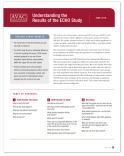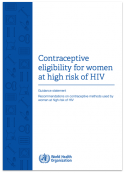- About UsOur Story, Our Team & Support Information
- What We DoAdvocacy to Achieve the End of AIDS
- Advance HIV/SRH Integration
- Advocate for Access to High-Impact Prevention
- Improve Research Conduct
- Product Innovation & Availability
- Promote Effective HIV Prevention Policy
- Strengthen Global Advocacy Networks
- Track and Translate the Field
- Our FocusInterventions to End the Epidemic
- ResourcesPublications, Infographics, Events & More
- MediaInformation & Resources for the Press
- Our BlogPrevention News & Perspective
One woman should have many choices to meet many needs. HIV prevention must be integrated with sexual and reproductive health.
Many women at risk for HIV are equally, if not more, concerned about avoiding or postponing pregnancy. Women urgently need access to information about contraceptives and HIV prevention, and they need expanded access to the full range of proven options for both.
In June 2019, results from the Evidence for Contraceptive Options and HIV Outcomes (ECHO) Study put these priorities sharply into focus. ECHO found no substantial difference in HIV risk among women using three methods of contraception – depot medroxyprogesterone acetate-intramuscular (DMPA-IM) also known as Depo-Provera, the copper intrauterine device (Cu-IUD), and a levonorgestrel (LNG) implant also known as Jadelle.
The findings from the ECHO study help to answer a decades-long question stemming from mixed data on past observational studies—some had suggested DMPA-IM might be associated with an increased risk of HIV, while others did not. ECHO also showed high rates of HIV incidence—at nearly four percent—among the study population of women and adolescent girls age 16-35 in East and Southern Africa. Taken together, these findings must spur action. The risk of HIV for women and girls remains alarmingly high, as do the risks to maternal health from unplanned pregnancies.
The ECHO trial provides important evidence to inform women’s choices, and to inform the integration of policies and programs for HIV and contraceptive services needed to support those choices. Access should be expanded to all proven HIV prevention options—including female condoms and daily oral PrEP—while continuing to invest in the development of new, women-controlled, HIV prevention options. In this context, the voices and priorities of African women must guide the conversation. AVAC works in partnership with groups and individuals in East and Southern Africa to prioritize and amplify womens’ issues and concerns.
What We're Reading
Featured Resources


